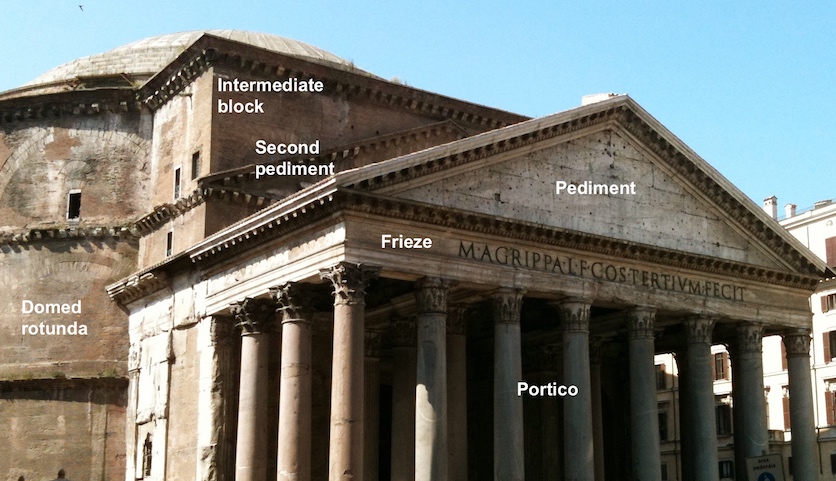

Stretching from the Atlantic Ocean in the west to the landlocked Caspian Sea in the east, the Empire’s territory encompassed southern and western Europe, northern Africa, and a sizable swath of western Asia – the furthest that its borders would ever reach. The reign of Hadrian arguably represented the greatest 'Golden Age' of the Roman Empire. ImageCourtesy of Wikimedia user Andrein under CC BY-SA 3.0 Save this picture! Under Hadrian’s reign in the early 2nd Century CE, the Roman Empire covered more territory than it ever would again. Sustainability and Performance in Architecture ISBN 0-966. Available at Amazon.The Future of Architectural Visualization The Great Buildings Collection on CD-ROM. bottom drawing second from right on the page. detail perspective drawing of capital, f100, p43. drawing of interior restoration, p255.ĭoreen Yarwood.
:max_bytes(150000):strip_icc()/Pantheon-510825247-crop-56aad7605f9b58b7d00901dd.jpg)
partial elevation drawing, plate 53, book four. interior elevation drawing, plate 58, book four. detail drawings of portico ornaments, plate 56, book four. Cambridge, MA: Harvard University Press, 1976.

The Pantheon : Design, Meaning, and Progeny. plan drawing showing floor pattern, plate 98. analytical drawing showing arcuated structure in walls, plate 106. New Haven, CT: Yale University Press, 1982. photo showing light shining into interior through oculus, f1.2, p4. Copyrighted slides in the Artifice Collection. photo of the prostyle octstyle portico of the Pantheon, f2.55, p46. interior photo of circular space, f4.35, p87. Classical Architecture: an introduction to its vocabulary and essentials, with a select glossary of terms. plan and section, p212.Ī nice graphic introduction to architectural ideas. figure-ground map of Rome at Pantheon, p111. large split section/elevation drawing, p109. plan and section drawings, p34.įrancis D. on holidays that fall on weekdays except for Christmas Day, New Year's Day and May 1, when it is closed. Originally, these exterior walls were faced with colored marbles.Īlso known as Chiesa di Santa Maria ad Martyres Hidden voids and the interior recesses hollow out this construction, so that it works less as a solid mass and more like three continuous arcades which correspond to the three tiers of relieving arches visible on the building exterior. The dome rests on a cylinder of masonry walls 6 m (20 feet). The dome is constructed of stepped rings of solid concrete with less and less density as lighter aggregate (pumice) is used, diminishing in thickness to about 1.2 m (4 feet) at the edge of the oculus. A whole sphere can be inscribed in the interior volume, with the diameter at the floor of the cylinder of 43.3 m (143 feet) equaling the interior height.įive rows of twenty-eight square coffers of diminishing size radiate from the central unglazed oculus with a diameter of 8.7 m (29 feet) at the top of the dome. The interior volume is a cylinder above which springs the half sphere of the dome. The dome has a span of 43.2 m (142 feet), the largest dome until Brunelleschi's dome at the Florence Cathedral of 1420-36. They support an entablature facing the square, which bears the famous inscription in Latin, attributing the construction to Agrippa, although the extant temple was rebuilt later by Hadrian. The portico consists of three rows of eight columns, 14 m (46 feet) high of Egyptian granite with Corinthian capitals. As the sun moves, striking patterns of light illuminate the walls and floors of porphyry, granite and yellow marbles. The only natural light enters through an unglazed oculus at the center of the dome and through the bronze doors to the portico. Opposite the door is a recessed semicircular apse, and on each side are three additional recesses, alternately rectangular and semicircular, separated from the space under the dome by paired monolithic columns. The interior volume is a cylinder above which rises the hemispherical dome.

Through great bronze doors, one enters one great circular room. Its monumental porch originally faced a rectangular colonnaded temple courtyard and now enfronts the smaller Piazza della Rotonda. It was built as a Roman temple and later consecrated as a Catholic Church. The Pantheon is one of the great spiritual buildings of the world. Poster Image - Pantheon Front Elevation Rendering


 0 kommentar(er)
0 kommentar(er)
